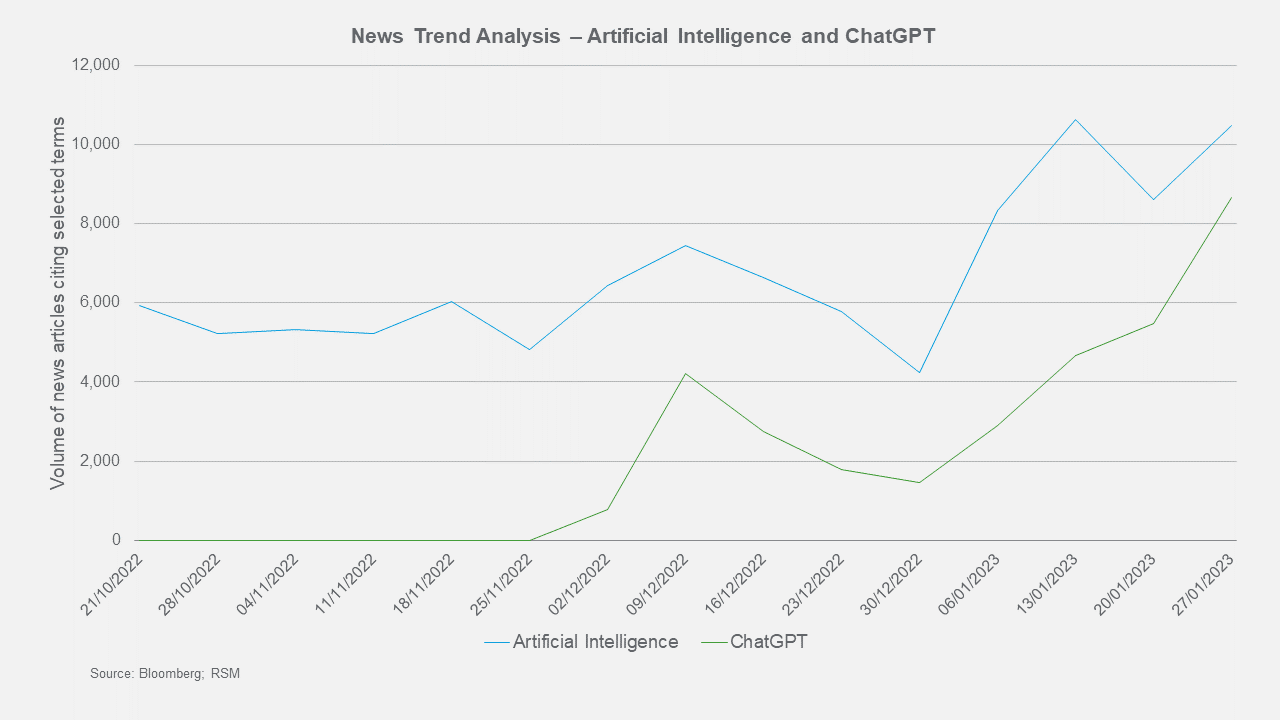You will almost certainly have heard of ChatGPT. Many will have experimented with it as the latest, and perhaps most approachable, Artificial Intelligence (AI) tool.
Data from Bloomberg indicates that by the end of January headlines and articles on ChatGPT alone rose to a level that almost matches those about AI in total. Some are even beginning to merge the meaning of the two terms. But what does this mean for business leaders, their markets, supply chains and their business?

What is ChatGPT?
ChatGPT is a generative text model (Generative Pre-Trained Transformer). It analyses enormous pools of text and can generate text-based answers to specific user requests.
Following the free-of-charge release of ChatGPT to the public, users across the world have been able to experiment with the tool, resulting in a great deal of excitement at how astoundingly well-structured and articulate the answers are, and curiosity at how human-like they appear.
The range of capabilities is expansive. It has been used to generate answers to simple queries (“What is the capital of Hungary?”), through to more complex reasoned summaries (“Outline the key areas to consider in a digital strategy for a mid-market business”), through to writing plays, books or songs (“Write me a comedic song about Adelle sailing a boat in the Caribbean”). And as you engage with the tool, you can ask it to modify the answer (“Change the song into a Haiku”).
ChatGPT is a machine learning model. It uses a form of artificial intelligence called deep learning, which is a subfield of machine learning that uses deep neural networks. ChatGPT is based on a variant of transformer architecture called the GPT (Generative Pretrained Transformer). The model was trained using a combination of supervised and unsupervised learning, where it was pre-trained on a large corpus of text data and then fine-tuned on specific tasks, such as answering questions or generating text. It sits on top of data-set that includes text from across the Web, books, blogs and news sites. The size of this database is not publicly discussed. Reportedly, 300 billion words were fed into the system and the tool has 175 billion parameters.
Who owns it?
The tool was developed by OpenAI, a research lab based in San Francisco. The lab was founded by a number of Silicon Valley investors whose vision was to develop tools for the “benefit of all humanity”. ChatGPT is just one of a range of AI solutions OpenAI are developing.
Microsoft are a significant investor in OpenAI, although the amount and terms are not published. The speculated amount is $10bn, possibly $14bn. The terms and nature of this (cash, shared resource etc) are, again, not publicly known, but it is expected to be enormous.
Where will I see ChatGPT?
ChatGPT is a visible, tangible advancement in Artificial Intelligence. You can participate in the open testing here - https://openai.com/blog/chatgpt/
If you are a Microsoft user, you might begin to see ChatGPT in your business systems. Microsoft have announced ‘Teams Premium’ which includes features powered by OpenAI. This includes the ability to generate notes, tasks and highlights of meetings. It can also create custom documents and watermarking. There is a feature called intelligent recap, used to generate notes and if your name is mentioned will draw you to the key areas in the transcript – particularly useful if you miss the meeting. It is very likely that the technology will advance to other Microsoft products in the Word suite.
Chat GPT3 is currently free – as part of open testing. There may be a time that the technology falls behind a paywall as the product is monetised. A premium version has already been announced at a cost of $20 a month, with a promise of faster response times and guaranteed access.
The computing power and cost required is enormous. Repeat users of ChatGPT are regularly met with a screen asking them to return later as servers are at capacity. Per a recent article in the Financial Times, analysts at Morgan Stanley have estimated answering a search query using language processing costs about seven times the cost of a standard internet search.
As the product is monetised, either as part of a broader software package (for example Microsoft Teams) or an isolated product, it will need to be configured to handle confidential data in accordance with ever increasing regulation. This is another expense that will come as the technology scales.
Many have commented that ChatGPT could herald an end to our reliance on search engines. This is likely premature based on the computing power and cost. In the meantime, a search engine still provides a range of very valuable options. For example, if you ask ChatGPT who won the Eurovision Song Contest in 2020 it will give you a succinct, and likely, correct answer. A search engine will give you the correct answer, images, links to the performance and other information - search engines are likely here for the near future.
What about more broadly?
As more AI is incorporated into business processes, the workforce may be concerned about their roles being replaced. When making these decisions, detailed understanding of the AI tools strengths and weaknesses is important. AI powered tools are fantastic at a number of things, principally:
- Speed - they are fast at generating a result, especially from vast data;
- Productivity - they can work 24 hours a day, 7 days a week; and
- They are becoming more sophisticated in their responses.
But, they do have weaknesses that are important to consider;
- The dataset – they are only as powerful as the dataset they sit upon;
- They are not creative – although give the impression they are; and
- Their increased sophistication makes them convincingly wrong.
The tools work by analysing broad tranches of data. ChatGPT for example sits on pre-2021 datasets, which means it will fail if you ask it who won the 2022 FIFA World Cup. For a business, this matters. For example, if a key team member is missing from a meeting and does not share a key update, the ChatGPT transcript/memo based on the notes will miss that vital data. The datasets define the capabilities and scope of the tool.
The ability to create poems, scripts and songs appears creative, but it’s crucial to consider how the tool is doing this. The tool is creating a response based on the information it can access – for example if you only fed the tool romantic comedies as a dataset and then asked it to write you a horror film the response would reflect the data it sits upon. The tools cannot take ideas and inspiration from outside datasets. From a business sense this is crucial as the tool cannot ‘think outside the box’ – a key element of strategic thinking required to be agile in a business environment.
With robots becoming increasingly sophisticated – they can also be convincingly wrong. ChatGPT isn’t perfect. The Times were able to expose a glaring error when asking for the five longest serving UK Prime Ministers (Margaret Thatcher and Robert Walpole cited as 2,912 and 2,901 respectively, whilst the true answer is much larger). Sometimes the devil is in the smaller, more obscure details. For example, when asked for broad guidance on how to select a winning runner in UK horse racing it gives reasonable and correct answers. When pressed on specific races it is unable to distinguish between the specific rules applying to each race. The advice it gives is misleading, but convincingly worded.
That said – ChatGPT it has also been used to pass University and professional exams with such aplomb that educators are concerned that ChatGPT could herald a new era of cheating. With such capabilities, ChatGPT may still add value even if it is not always right. The question is not necessarily whether the tool is perfect, but is it better than a human?
2023 appears to be the year that Artificial Intelligence is firmly on the boardroom agenda. There will be challenges for business leaders in both educating and reassuring workforces about tools as they are integrated into the business. To do this, business leaders will need to develop an awareness of how these tools are designed and how they work.
At best, once this is achieved, they will be better placed to wield these tools and leverage the opportunity to boost speed, capacity and productivity. At worst, a blind acceptance of the tool could lead to significant misunderstandings and mistakes.
This is a fast-evolving space, one well worth monitoring.





